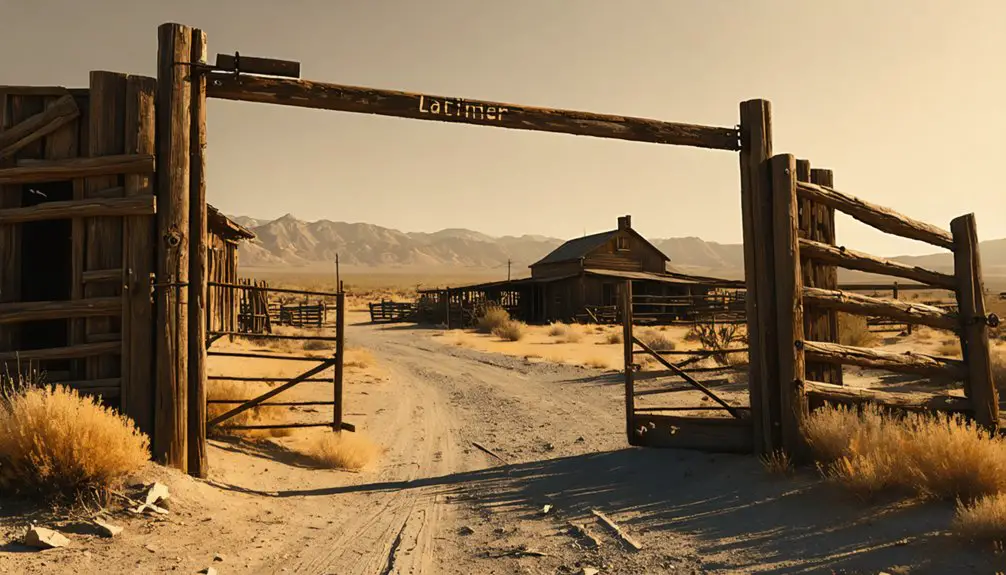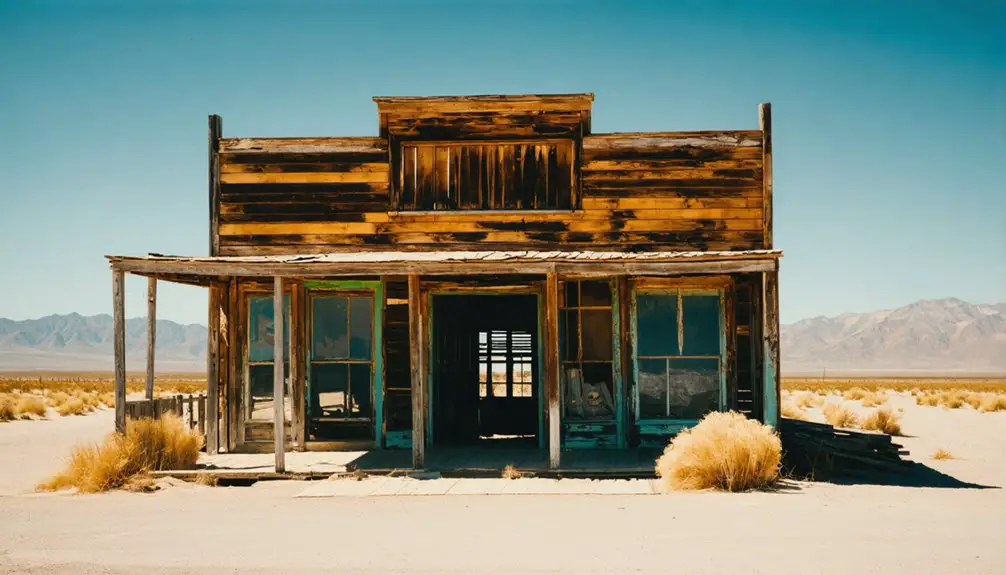You’ll discover Indian Springs ghost town 45 miles northwest of Las Vegas, where ancient springs once sustained Native American settlements before becoming a crucial mining and railroad hub in the early 1900s. The area thrived around Wheelbarrow Peak’s gold deposits, with miners facing harsh desert conditions and daily struggles in the camps. While the mining operations eventually declined, the site’s legacy lives on through Creech Air Force Base and preserved historic remnants that tell a complex tale of survival and transformation.
Key Takeaways
- Indian Springs began as a railroad town in 1906 during the Las Vegas and Tonopah Railroad era, serving as a crucial watering station.
- Mining operations employed 135 workers extracting high-grade gold from arsenical ores until declining ore values forced closure.
- The town’s harsh desert climate, with only 6 inches annual rainfall and extreme temperatures, challenged residents’ survival.
- Economic pressures and resource depletion in the mid-20th century led to the abandonment of mining operations.
- Establishment of Creech Air Force Base in 1942 transformed the ghost town into a military community.
Origins of the Natural Springs and Native Settlements
While southern Nevada is known for its arid landscape, Indian Springs stands out as a geological marvel where ancient groundwater systems create natural oases.
You’ll find these springs emerging where underground water encounters fault boundaries and less permeable rock formations within the valley’s extensive basin-fill sediments.
The springs’ origins trace back to a complex interaction between Paleozoic to Tertiary rocks and thick deposits of gravel, sand, and clay from the Pliocene and Pleistocene ages. The area features distinctive yellow and orange shales that characterize the geological formations of the region. The valley receives approximately 500 acre-feet of annual precipitation that contributes to the groundwater system.
Ancient layers of rock and sediment, spanning millions of years, converged to form Indian Springs’ remarkable geological foundation.
These geological features created perfect conditions for indigenous settlements, who recognized the springs’ life-sustaining potential. Native American groups established year-round camps around these reliable water sources, using them as bases for hunting and gathering.
The springs became crucial markers on travel routes and sacred spaces for cultural ceremonies.
The Railroad Era and Early Development
Although Indian Springs existed as a natural oasis for centuries, its transformation into a bustling waypoint began with the arrival of the Las Vegas and Tonopah Railroad in 1906.
You’ll find the town’s development was shaped by fierce railroad competition between LV&T and the Tonopah and Tidewater Railroad, as companies raced to serve Nevada’s booming mining districts.
The LV&T established Indian Springs as an essential watering and resupply station, completing 75 miles of track by May 1906.
Construction teams overcame challenging terrain to lay rails under what’s now U.S. Route 95, enabling efficient mining logistics between Las Vegas and Beatty.
The Clark-owned LV&T made its only profitable year during its first year of operation.
Like many place name disambiguation cases in Nevada, Indian Springs shares its name with several other locations across the United States.
The railroad’s presence spurred the town’s growth until 1918, when LV&T ceased operations.
This closure marked the end of Indian Springs’ prominent role as a railroad hub, though its infrastructure laid the foundation for future developments.
Mining Operations at Wheelbarrow Peak
Since its discovery, Wheelbarrow Peak‘s complex geological composition has yielded diverse ore deposits, including orpiment, stibnite, pyrite, arsenopyrite, and free gold.
You’ll find that mining innovations at the site focused on conventional open-pit methods, with specialized blasting crews and multiple daily shifts maintaining steady ore extraction. The operation employed around 135 workers, including 90 mining personnel, 30 processing staff, and 14 administrators.
The peak’s unique mineralogy produced exceptionally pure gold from its arsenical ores, distinctly different from typical deposits with 70% fineness.
The surrounding area contains significant deposits of hornfels and limestone that influenced the region’s mineralization patterns. Mining activities carefully avoided groundwater depths, while operations managed approximately 100-200 acres of permitted disturbance. The site’s infrastructure included extensive haul roads connecting pit areas to processing facilities, where sulfide and arsenical ores underwent treatment.
Life in the Mining Camp
If you’d spent time at Indian Springs mining camp between 1865 and 1910, you’d have faced harsh living conditions in either a tent or one of the few stone cabins built near Wheelbarrow Peak.
You would’ve shared the camp with no more than 15 other residents at any given time, mostly miners working the tungsten deposits and a handful of support workers.
The challenging climate, with hot summers and cold winters, combined with the lack of infrastructure and basic amenities, made daily survival a constant struggle for the camp’s inhabitants. Workers relied on wells for water and had to generate their own power on-site. The camp’s eventual downfall came when reduced ore values forced the mill to shut down.
Daily Struggles Underground
When miners descended into the depths of Indian Springs’ underground tunnels, they faced a grueling world of physical and psychological challenges that defined their daily existence.
You’d find yourself stooped in narrow passages for 10-12 hour shifts, straining under dim lamplight while battling extreme temperatures. The daily dangers were relentless – cave-ins, floods, and toxic gases lurked in poorly ventilated shafts.
Your miners’ health deteriorated quickly from constant dust exposure, leading to deadly respiratory diseases like silicosis. Working in teams, you’d drill, blast, and haul ore while fighting exhaustion and mental fatigue. Like the workers in McGill who received two cents after company deductions, miners struggled to make ends meet.
The darkness and isolation took their toll, fostering anxiety and fear. Your earnings depended on ore output, yet company stores drained your wages through inflated prices, trapping you in a cycle of economic dependency. These harsh conditions were common across Nevada’s mining boomtowns, where thousands sought their fortunes in precious metals.
Camp Housing and Facilities
After grueling shifts underground, miners returned to the stark realities of life in Indian Springs’ mining camp.
You’d find yourself packed into simple wooden shacks or canvas tents, sharing cramped quarters with fellow miners. The camp layout centered around a communal well, with basic sanitation facilities consisting of rough outhouses scattered throughout the settlement.
You couldn’t expect many comforts here – meals were cooked over open fires, and you’d rely on the camp’s general store for basic provisions. Without refrigeration, you’d survive mainly on preserved foods and dry goods. If you encountered any issues with access to supplies, you’d need to consult an administrator about getting items approved.
At night, you’d gather with others around campfires, sharing stories and music to lift spirits. While the living conditions were harsh, with extreme desert temperatures and dusty winds, the shared experience created a tight-knit community of determined souls.
The Lattimer Ranch and Local Conflicts

You’ll find the historic Lattimer Ranch, established by George and Belle Lattimer around 1906, at the site that later became Indian Springs Hotel & Casino before its 2014 closure by the USAF.
Their ranch operation faced early challenges when George suffered a severe spider bite requiring urgent medical care in Los Angeles, leaving their teenage Paiute ranch hand Coachie Siegmuller to guard the property.
During the Lattimers’ absence, Siegmuller fatally shot the notorious “Wild Bill” Williams on the ranch porch – an incident that sparked tensions between settlers and the local Paiute community until authorities commuted Siegmuller’s death sentence to three years’ imprisonment.
Ranch Location and Operations
Located in Indian Springs, Nevada, the historic Lattimer Ranch occupied a strategic position near natural springs that had long served Native American settlements in the area.
George and Belle Lattimer established their ranch around 1906, operating alongside the Indian Springs Hotel & Casino until its closure in 2014. The property’s proximity to the Las Vegas and Tonopah Railroad line made it a vital waypoint for travelers until 1918.
Ranch life centered on livestock management and property maintenance, with significant support from local Paiute workers. Most significantly, a young Paiute boy named Coachie Siegmuller helped with daily operations and even watched over the ranch during the Lattimers’ absences.
The ranch’s location near what would become Creech Air Force Base ultimately influenced its operations and the surrounding community’s development.
Lattimer Family History
While George and Belle Lattimer established themselves as prominent settlers in Indian Springs during 1906, their ranch became the epicenter of dramatic local conflicts that shaped settler-Native American relations.
The Lattimer legacy took a pivotal turn when George suffered a severe spider bite, requiring hospitalization in Las Vegas. During their absence, they left Coachie Siegmuller, a 16-year-old Paiute worker, in charge of the ranch.
Paiute relations reached a breaking point when Coachie fatally shot Bill “Wild Bill” Williams, a notorious exploiter of young Native American workers. The incident sparked threats of armed conflict from the Las Vegas Indian Colony, leading authorities to reduce Coachie’s death sentence to three years imprisonment to maintain peace between settlers and the Paiute community.
Fatal “Wild Bill” Incident
The tragic events at Lattimer Ranch in 1906 cast a dark shadow over Indian Springs’ early history. When George and Belle Lattimer left their property due to a poisonous insect bite, they couldn’t have predicted the fatal confrontation that would unfold.
Paiute tensions erupted when “Wild Bill” Williams, known for his exploitative practices against Native laborers, arrived to collect extorted wages.
Key elements of this dark chapter include:
- Young Coachie Siegmuller’s violent response to Williams’ presence, shooting him while he slept.
- Community intervention that reduced Siegmuller’s death sentence to three years.
- Williams’ troubled burial site, which spawned persistent ghost stories and local folklore.
This incident remains deeply woven into the area’s cultural memory, highlighting the complex historical narratives of Native American conflicts and legal consequences in early Nevada.
Desert Climate and Environmental Challenges

Despite receiving a mere 6 inches of annual rainfall, Indian Springs endures some of Nevada’s harshest desert conditions, with scorching summers reaching 100°F and winters dipping to near-freezing temperatures.
You’ll find the region’s harsh climate demands remarkable desert adaptation from both wildlife and vegetation, as they cope with extreme temperature swings and persistent water scarcity.
If you’re exploring this area, you’ll notice the environmental challenges are stark. The intense sun beats down for about 295 days annually, while strong winds of 8-11 mph whip across the landscape, causing soil erosion and dust storms.
The minimal precipitation, occurring only 30 days per year, means you’ll see limited surface water and sparse vegetation, making water conservation essential for survival in this unforgiving terrain.
Decline and Abandonment of the Mining Site
As economic pressures mounted in the mid-20th century, Indian Springs’ once-thriving mining operations faced a perfect storm of challenges that sealed their fate.
The combination of resource depletion, economic downturns, and technological limitations created unsustainable conditions for continued mining operations.
You’ll find three key factors that drove the site’s abandonment:
- Depleted tungsten, fluorite, and precious metal deposits made resource management increasingly difficult, while declining ore grades reduced profitability.
- High operating costs and global market competition crushed profit margins during the Great Depression and subsequent decades.
- Limited infrastructure investment and outdated mining technology couldn’t overcome the challenges of the remote desert location.
The exodus of workers and support services soon followed, transforming Indian Springs into yet another Nevada ghost town, joining countless others that fell victim to similar circumstances.
The Indian Springs Hotel & Casino Legacy

Standing as a tribute to Nevada’s rural gaming history, Indian Springs Hotel & Casino operated from 1985 to 2014, offering visitors a quintessential desert oasis experience.
Owned by the Lattimer family, this 16.9-acre property featured a complete resort setup with a casino, hotel, restaurant, bar, and gas station.
You’d have found classic gaming options like blackjack, poker, and slots, alongside amenities that served both tourists and locals.
However, the casino’s story came to an end when the U.S. Air Force initiated a military acquisition to expand security around Creech Air Force Base.
The casino closure marked the end of an era, as the Air Force’s plan included demolishing all private structures.
Today, the property’s legacy lives on as a reminder of rural Nevada’s gaming culture before military expansion reshaped the landscape.
Impact of Creech Air Force Base
While Indian Springs began as a modest desert settlement, Creech Air Force Base has transformed the area into a significant military hub since its 1942 establishment.
You’ll find the base’s military presence has deeply shaped the community’s evolution, especially through its role as a global command center for drone operations and the USAF Thunderbirds’ training ground.
The base’s impact on Indian Springs is evident through:
- Expanded security measures, including the acquisition of the Indian Springs Casino Resort to create essential security buffers
- Economic influence via military and civilian jobs, driving local employment and housing demands
- Strategic significance as a UAV Battlelab and emergency divert airfield for the Nevada Test and Training Range
Creech AFB’s continued growth and enhanced security requirements keep reshaping this desert community’s identity and development patterns.
Preserving the Ghost Town’s History
Through extensive preservation efforts, Indian Springs’ historical legacy continues to thrive under multiple layers of protection.
You’ll find the site’s cultural heritage safeguarded by the National Historic Preservation Act of 1966, with federal and state agencies working together to protect archaeological discoveries and historical structures.
Preservation techniques focus on “arrested decay,” allowing you to experience authentic remnants while preventing further deterioration.
Preserving history means finding the delicate balance between maintaining authenticity and protecting artifacts from time’s relentless march forward.
Local water district boards and the U.S. Bureau of Reclamation collaborate to protect both natural and historic resources.
You can explore the site through educational signage and interpretive materials that bring frontier life to light.
Academic partnerships guarantee ongoing documentation and research, while community-led initiatives keep the town’s stories alive through organized events and advocacy efforts that balance public access with site protection.
Frequently Asked Questions
Are There Any Paranormal Activities Reported in the Abandoned Mining Sites?
Picture crumbling mine shafts echoing with silence – you won’t find verified ghost sightings or mining spirits here. While nearby Nevada towns report paranormal activity, there’s no documented evidence at these specific sites.
What Happened to the Native American Artifacts Found in Indian Springs?
You’ll find many artifacts were recovered and preserved from Pintwater Cave during 1963-64, including wooden darts and projectile points. Their cultural significance remains contested between museums and local tribes seeking repatriation.
Can Tourists Still Access Any Parts of the Original Ghost Town?
You can access some parts of the ghost town but expect limited tourist attractions. You’ll need to stick to public roads and trails, as many original structures are on private property.
Were There Any Notable Gold or Silver Discoveries Near Indian Springs?
While you won’t find major gold rush sites at Indian Springs itself, you’re near historic mining boom areas like the Comstock Lode silver discovery and Eldorado Canyon’s gold deposits from 1861.
Did Any Famous Outlaws or Historical Figures Visit Indian Springs?
You’ll find only one notable outlaw sighting: “Wild Bill” Williams, who exploited Paiute workers before meeting his end at the hands of 16-year-old Coachie Siegmuller. Other historical visitors weren’t documented.
References
- https://en.wikipedia.org/wiki/Indian_Springs
- https://nevadamagazine.com/issue/january-february-2016/3009/
- https://www.ghosttowns.com/states/nv/indiansprings.htm
- https://travelnevada.com/nevada-magazine/ghost-town-primer/
- https://nvtami.com/2024/07/23/ely-explorations/
- https://data.nbmg.unr.edu/public/Geothermal/GreyLiterature/Maxey_SouthernNVResources_1948.pdf
- https://pubs.usgs.gov/wri/1995/4168/report.pdf
- https://ngmdb.usgs.gov/Geolex/UnitRefs/IndianSpringsRefs_5639.html
- https://en.wikipedia.org/wiki/Indian_Springs_Valley_(Nevada)
- https://www.mindat.org/loc-84261.html



